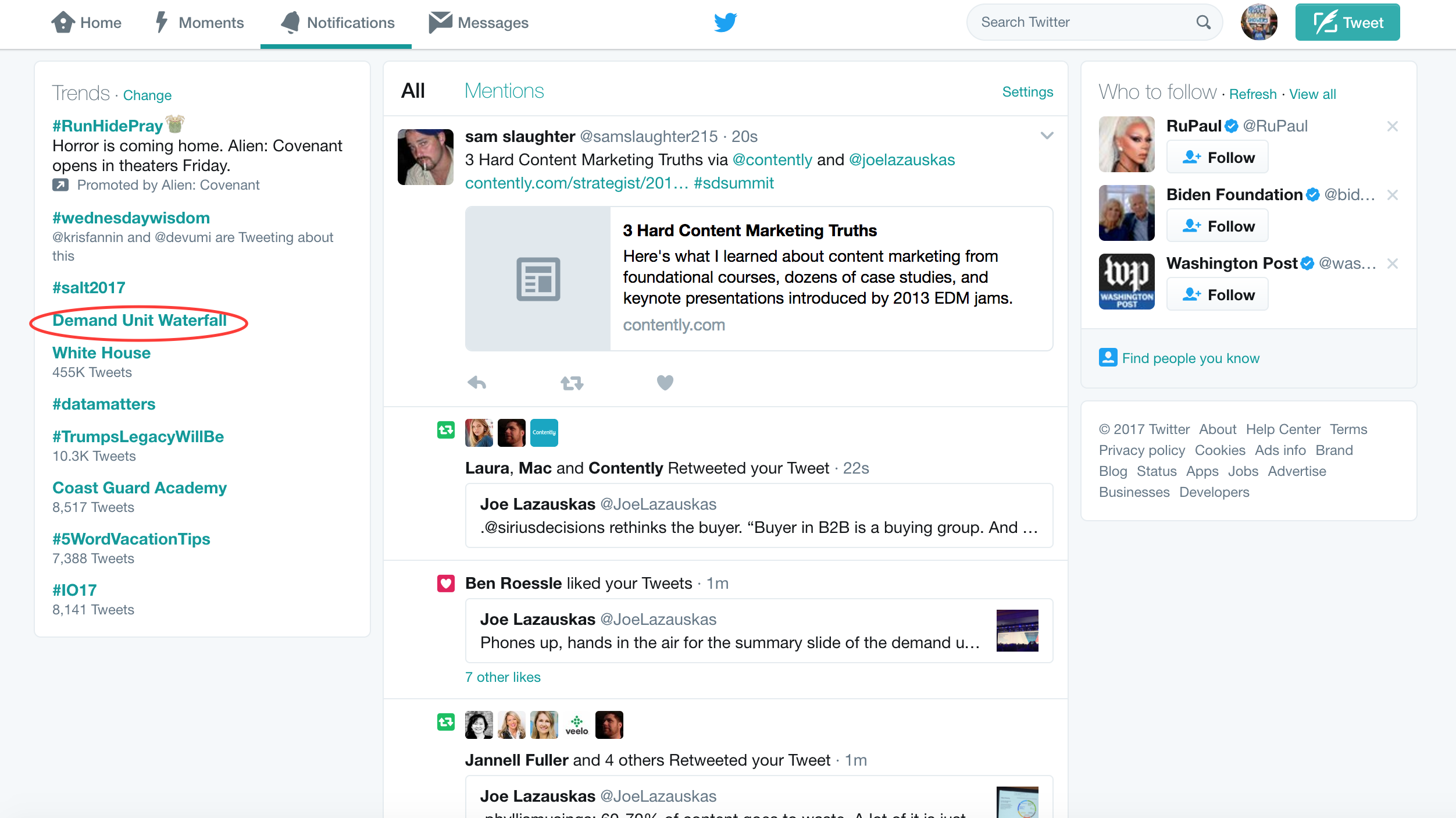ROI
The New Demand Waterfall, and Other Next-Level Marketing Insights You Need to Know
There was a drum roll as the thousands in the crowd hushed. Then it came. Arms shot in the air in spiritual ecstasy. iPhone cameras flashed.
What was it? Beyonce? Bono? Michelle Obama? The Pope? No. To the crowd of marketers at Day 2 of the Sirius Decisions Summit in Las Vegas, it was something far more exciting: a new SiriusDecisions Demand Waterfall.
By the 10:20 networking break, the new waterfall was the topic of nearly every conversation I heard. It set the theme for the day: next-level marketing frameworks that have the potential to transform the way you work.
Here are the biggest insights you need to know about.
1. The New SiriusDecisions Demand Waterfall
Ever since it was introduced in 2006, the Sirius Decisions Demand Waterfall has been the bible for thousands of B2B marketers.
The waterfall is basically the funnel on steroids—a much more sophisticated way of thinking about lead management. Sirius hadn’t updated it since 2012, so the new framework was big news to the point that it quickly trended on Twitter in Las Vegas.

And people were hyped. Real hyped.
That moment when the newest #demandwaterfall is revealed to a room full of marketers #SDsummit pic.twitter.com/MqT0mUFra3
— Stephanie Guttman (@saas_stephanie) May 17, 2017
There’s a lot to unpack in the new waterfall—Andrew Gaffney of DemandGen report has a great summary here. But the simple yet powerful idea at the center of it is viewing opportunities as buying groups, not as individuals. That’s because very rarely does the decision to buy a B2B product come down to only one person.
These groups are “demand units,” and the theory is that viewing them as such enables you to qualify opportunities better and market to them accordingly. This, in turn, boosts sales efficiency and enables you to measure conversion rates more effectively. For instance, if 10 marketers from the same group come inbound, and you sell to one, your conversion rate should be 100 percent rather than 10 percent. Viewing disconnected teams within large organizations as different buying groups has huge benefits as well. Dig into Gaffney’s write-up for more details.
2. Content marketing software is now “non-negotiable”
One thing I love about SiriusDecisions is that the company is not afraid to put its stake in the ground on key marketing issues.
On Day 1, content strategy researcher Phyllis Davidson’s did just that by defining content marketing as ToFu (top-of-funnel) inbound marketing. (A logical opinion that I don’t necessarily agree with and will tackle in an article soon.) On Day 2, Davidson, along with research director Christine Polewarczyk, made the bold declaration that content marketing software is now non-negotiable.
.@christine_mktg: Content mark software is now a prerequisite. Evaluating options? Here are 10 Qs to ask #SDsummit https://t.co/lzsIu4WR3X pic.twitter.com/WC0H6fUOxc
— Contently (@contently) May 17, 2017
According to Davidson and Polewarczyk, content marketing software is central to solving two problems. First, you need a central platform to help you access the 60-70 percent of content that goes unused. Second, you need to measure both production and performance metrics in one place. That’s the only way to have a true view of how your content is performing.
The presentation also featured live polls through the SiriusDecisions app. Fittingly, attendees ranked the lack of content marketing software as their biggest pain point. (I couldn’t help but shill Contently’s solutions page.)
#sdsummit attendees pinpoint content marketing software as their biggest pain point. Check out @contently! https://t.co/RL2YeSgBBb pic.twitter.com/nHJCcC65eV
— Joe Lazer (@JoeLazauskas) May 17, 2017
Lastly, when the presentation showed several different dashboard set-ups, I wanted to stand up and scream AMEN. Simple dashboards like this will definitely be the key to the rapid and continuous optimization of content marketing programs:

3. The gated content backlash is coming
This vibe was palpable throughout several sessions at SiriusDecisions. We know that most B2B buyers conduct extensive research before raising their hand and becoming a lead. We know that less than 10 percent of our potential market is going to raise their hand and become a lead. And we know that B2B buyers hate filling out forms. So then why the hell do we keep our best and most useful content hidden behind a wall?
Yep. Biggest problem in B2B marketing. #SDSummit pic.twitter.com/3GU31q3PSo
— Joe Lazauskas (@JoeLazauskas) May 17, 2017
Over the past six months, I’ve grappled with the pros and cons of gated content. (So have a lot of other marketers.) On one hand, I’ve created nearly 100 different gated e-books, webinars, and interactive features at Contently, and it’s certainly delivered a ton of inbound juice for us. But on the other hand, I hate filling out forms and abandon content all the time because I don’t want to do so. Deep down, I believe that the best long-term strategy should focus on making it as easy as possible for your target audience to engage with your content.
We’ve been shifting strategies at Contently and gating a lot less content this year. As we move through the rest of 2017, don’t be surprised to see a growing anti-gating wave.
Image by Novintito /GettyGet better at your job right now.
Read our monthly newsletter to master content marketing. It’s made for marketers, creators, and everyone in between.




